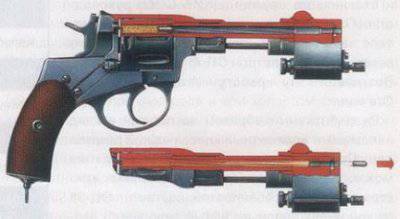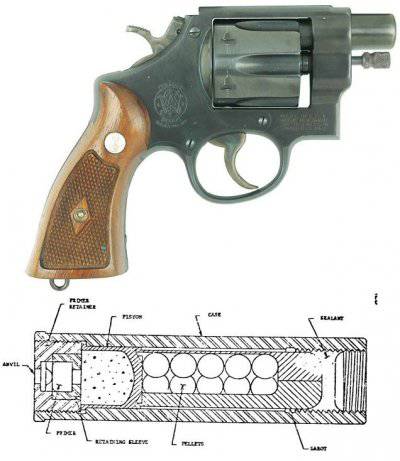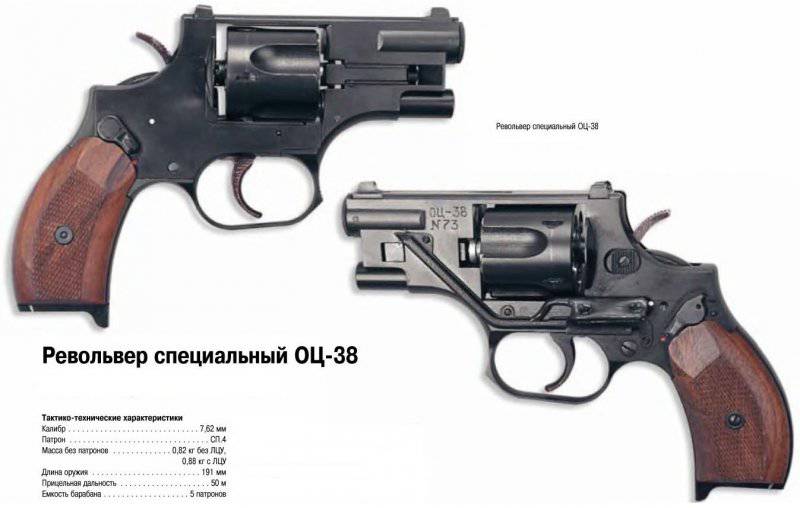Weapon Miracles: Cowboy's Silent Dream
The smoke was sorted out at the beginning of the last century, when nitrocellulose powders appeared and came into use. Noise, in turn, did not want to go anywhere. Various attempts were made to get rid of him and not all of them were unsuccessful. In 1909, in France, a certain E. Kiosa received a patent for a new way of silencing the sound of a shot. He proposed to use a special wad in hunting weapons, which, when fired, remained in the gun barrel and locked gunpowder gases in it. The latter could not contact with the surrounding air and due to the temperature difference create so-called. muzzle sound wave. In our country, such a system will later be called the “powder gas cut-off” and will be used in special cartridges, where the wad-piston will remain inside the spent cartridge case. Before the appearance of such munitions in our country, experiments were also carried out with weapons that isolate powder gases.
 Mitin brothers project
Mitin brothers projectThe first were the brothers VG and I.G. Mitiny. The ones that will create the famous Bramite device in the thirties. But before the creation of this silencer, almost ten years remained, and the Mityans worked on other projects of a similar purpose. In 1929, the brothers received a patent for a new “for silent shooting” revolver. According to the general concept, he resembled the construction of the Frenchman Kiosa, but it was a multiply-charged weapon. They took the good old "Nagant" as a basis for a silent revolver, and based on the cartridge 7,62x38 mm Nagant a special ammunition was created. The reasons for this choice are simple: the “revolver-cartridge” complex of the Nagant brothers system was designed in such a way that when the shot was fired, no powder gases escaped from the breech breech. Thus, the powder gases could be safely locked in the barrel and not allow them to create a sound wave. The cartridge of Nagan was slightly modified — the bullet caliber was reduced, and the gap between the sleeve sleeve and the bullet was filled with a special cylindrical pan, or, as was written in the patent, a “pan”. The revolver itself has undergone much more modernization. A special device resembling a revolver's drum was installed on the muzzle. The drum barrel was connected to a revolving common axis. Inside the muzzle drum, six channels with a variable diameter were made: from the “breech” part it was equal to the caliber of the barrel, and in the “muzzle” it was equal to the caliber of the bullet. The work of the system looked quite interesting. When a shot was fired (double-action firing mechanism), a bullet with a pallet passed through the barrel of a revolver and acquired rotation. Having reached the canal of the mundane drum, the pallet rested against its “step” and remained in the canal. The bullet by inertia separated from the pallet and flew into the target. The powder gases remained locked in the sleeve, the barrel and the closed channel of the barrel of a barrel, and then gradually exited through the existing gaps. When the next shot was fired, the drum of the revolver was turned along with the barrel and the new cartridge and the variable diameter channel were brought to the barrel. The second bullet, respectively, also left its podsink in the muzzle drum. After the entire ammunition was used up, the new cartridges were placed in the chambers using a standard clip, and the pallets remaining in the channels of the barrel drum had to be manually removed using a small ramrod.
Unfortunately, the silent revolver of the Mitin brothers did not go into the series. Moreover, there is still no reliable information about the existence of at least a prototype. For this reason, it is possible to speak about the effectiveness of the system of silencing applied to a revolver only on the basis of the results of a mental experiment. So today a revolver for silent shooting is available only in the form of a few drawings, diagrams and other similar documents.
 Weapons for "tunnel rats"
Weapons for "tunnel rats"But the American revolver QSPR managed to reach the series. In the late 60-x, when the US military had just "tasted" all the charm of the Vietnam War, they needed a special weapon that allows you to effectively deal with the enemy in difficult conditions. First of all, a weapon was needed for the so-called. tunnel rats. These elite fighters needed special small-sized weapons with good destructive power and the lowest possible shot noise. Small dimensions were required for ease of circulation in the closed space of the Vietcong tunnels, destructive force was needed to ensure the defeat of a sudden enemy, and the reason for the noise requirements was the peculiarity of sound propagation in confined spaces. In addition, in addition to the negative effect on the shooter himself, a loud shot could easily have attracted the attention of the enemy.
Combining all three principles in one weapon was entrusted to the gunsmiths of the ARL (Army Research Laboratory) Aberdeen laboratory. Due to the complex requirements for new weapons, the designers needed to combine several solutions at once from various areas of the arms business. The size issue was decided by taking the Smith and Wesson Model 29 revolver as a basis for the new weapon. Reliable defeat of the enemy and low noise were provided by a new design cartridge developed by AAI. Powder gases in it are locked with a special piston. However, the piston knocks out not a bullet from the sleeve, but a half dozen tungsten pellets with a diameter of about half a millimeter each. The weapon was named QSPR (Quiet Special Purpose Revolver - Quiet Special Purpose Revolver). Most of the Smith & Wesson Mod nodes. 29 moved to QSPR almost unchanged. Thus, the trigger mechanism retained the double-action design, and the drum still held six cartridges. At the same time, the new cartridge demanded to bore the drum chambers and replace the barrel. The Model 29's native long rifled barrel was replaced by a short (35 mm) smooth 10 mm barrel. When fired, the piston located inside the cartridge pushes a special dividing tray with shot through the muzzle of the sleeve. The relatively short barrel (3,5 caliber) does not contribute to the acceleration of the bullet / shot, therefore, at the exit from the muzzle, the pan with the shot has a speed of only about 220 meters per second. The situation is similar with muzzle energy - of the order of 180-190 J. At a distance of a meter from the shooting, the sound of a shot, due to the cutoff of powder gases, has a volume of slightly more than one hundred decibels, which is approximately equal to a small-caliber pistol with an expansion-type silencer.
The relatively low performance of the QSPR revolver resulted in its being used exclusively in tunneling operations. There were precedents when the weapon was used in ambushes, but the effective firing range of no more than ten meters did not allow the revolver to become a familiar weapon for such purposes. However, the pre-production batch of ten copies sent to the troops in 1969 received good feedback from the fighters and adopted QSPR. Regarding the exact number of released revolvers, there is no data - in different sources the number in 25, 50, 100 and even 250 units is called. There is no information about the use of "tunnel revolvers" after the end of the Vietnam War.
Grunts and kills
In 1983, in the USSR, a silent pistol complex consisting of an MSS pistol and a special SP-4 cartridge (7,62x41 mm) was adopted. The specific features of the gas cut-off cartridge - unlike their predecessors (SP-2 and SP-3), its wad-piston does not protrude from the cartridge case after the shot - allowed creating a self-loading pistol and promised even greater prospects. However, it came only in the middle of 4-x to expand the range of weapons chambered for SP-90. In 1996, the FSB ordered the Tula TsKIB SOO revolver, designed to use a silent cartridge. The project was named "Growler" and the internal index OT-38. The work on the topic was headed by the famous designer I.Ya. Stechkin. As some weapon lovers rightly point out, the OC-38 is not something revolutionary new - it just contains some very good technical solutions. Among them are interesting. In appearance, the "Growler" is almost no different from other revolvers. At first glance, a laser pointer under the barrel catches the eye. But in this case, the first impression is deceptive - LCC really exists, but it is located not under the barrel, but above it. Those. what appears to be a barrel (upper “pipe”) is in fact a target designator, and the barrel of the revolver is located below. This has improved the accuracy due to a more rational distribution of the recoil momentum. Accordingly, the shot is made from that chamber of the five-shot drum, which is currently in the lowest position. OZ-38 has a double action trigger with an open trigger and the possibility of pre-cocking. Such an “echo” of the single action mechanisms required the introduction of a non-automatic fuse. It is noteworthy that the fuse can be turned on only if the trigger is cocked. Thus, the shooter does not need to remember about the fuse, if he is going to shoot from the pickup. The revolver is loaded with clips for five SP-4 cartridges. To do this, the drum leans to the right of the shooter. The "grumbler" has open sights, consisting of unregulated rear sight and front sight. In this case, the front sight is placed on the upper surface of the casing of the laser pointer. In the same casing there is a compartment for the batteries of the LCC, and the button for turning it on is placed on the frame of the revolver and is located above the trigger on the left. To activate the LCC, it is required to slightly extend the thumb of the shooting hand.
In 2002, the OZ-38 revolver was adopted by the special forces of the FSB, but the designer Stechkin did not wait for this - he died 28 on November 2001. For obvious reasons, the latest creation I.Ya. Stechkin and ten years after its adoption is little known, and as for its use, there is no open information on this subject. You can only make assumptions. After all, even the fact that the sleeves remain in the drum after the shot makes it possible to put forward a version about some adaptability of the OTs-38 revolver for operations to covertly eliminate “objects”.
***
Finally, you need to make one small reservation. The silent revolver Mitin, QSPR and OTs-38 are not the only examples of weapons of this class with the ability to fire without noise and flash. However, in the overwhelming majority of cases, the designers solved the problems of sound only by equipping the existing revolvers with noiseless firing devices. It must be said that, against the background of the solutions applied by Mitin, Stechkin and engineers of the Aberdeen laboratory, a revolver with a silencer looks too trite.

Information